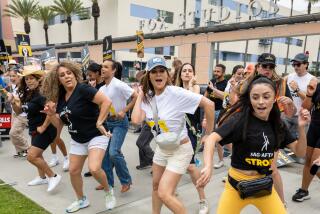Imaging System May Offer Peek at Pec Potential : Global Deal Would Let Body Builders See the Results in Advance
A San Diego firm that was the first in the country to show plastic surgery patients what their nose jobs would look like before they faced the surgeonâs scalpel now wants to provide similar previews for health club members.
Global Imaging, a Solana Beach firm with only 10 employees, may soon close a $6-million deal to make computer imaging systems that will show body builders or those who want to lose weight what they can look like, before pumping an ounce of iron or losing a drop of sweat.
âItâs an incentive for the potential club member to visualize themselves, to see what the benefits will be. . . . Itâs a motivating tool,â said Michael Guberek, one of Global Imagingâs founders and inventors of the imaging systems.
Depends on Test Runs
The contract--with Health and Tennis Corp. of America, a Los Angeles-based subsidiary of Bally Corp. and the operator of 315 sports and fitness clubs throughout the country--still depends on a number of test runs. The imaging product is temporarily named BodyVision until a trademark search is finished.
âWeâre researching it and we think itâs terrific. Other than that, we canât comment,â said David Church, Health and Tennis Corp.âs director of public relations.
BodyVision is another version of a computer-imaging program called System 9000, developed six years ago and marketed in 1985. The system, a combination of computer, video monitor and camera, converts satellite pictures into map projections. It uses a process called image registration, which allows alteration on the video screen.
Guberek said he and company co-founder Stephen Borders were the first in the nation to introduce a full-color imaging program for cosmetic and plastic surgery. The system is based on a digital image processing system designed primarily for scientific and military uses.
Reconstructing Pictures
âSatellites send down pictures and images, which come down as radio signals, and you have to reconstruct the pictures out of those radio signals,â Guberek said. âYou have to do things like correct for the Earth curvature, atmospheric disturbances and so forth.â
âOne of the key developments of the system was a process called image registration,â he said. âThis process allows you to warp an image to fit a desired shape. For example, when a satellite is looking at the Earth, (the Earth) looks like a ball, but a military analyst might want to look at a flat surface. That process, of turning the ball into a flat image, is image registration.â
Global Imagingâs satellite imaging systems have been bought by Scripps Institution of Oceanography, the National Weather Service, the Navy and the National Aeronautics and Space Administration.
The company then used the same concept to create what it calls the Imagemaker, an $18,500 version of the system that is designed for cosmetic surgeons, and, in October, 1987, a $19,500 version for hair stylists.
Beauticians, salon owners and hair stylists can take a photograph of a client, put it on the screen and point an electronic pen at the ear lobes, chin and bridge of the nose. This tells the computer the shape and size of the face and creates a hair style--any hair style--to fit the clientâs face exactly.
A competitor, New Image Industries in Canoga Park, has had a similar system on the market since March, 1987, that retails for between $13,000 to $22,000. Kirk La Mar, executive vice president of New Image, said about 600 salons across the country are using his companyâs system.
New Image also markets a program that allows landscape architects to show homeowners what the addition of a few bushes or an entire back yard could do for their houses. The company is also looking into markets for cosmetic dentistry, plastic surgery and optometry.
Guberek said his Imagemaker for hair gives a better result and that New Imageâs computer does not measure the face of the client.
âYou have the clientâs face on the screen, then a wig appears on the screen, and, with the electronic pen, you drag it up and down and left and right until it fits on the clientâs face,â Guberek said. âBut, because there is no image registration, you might get gaps between the hair and the face.â
However, La Mar, who owns two salons and has styled hair for 12 years, counters by saying his product has a flexibility that the Imagemaker does not.
âGreat Communication Toolâ
Newport Beach plastic surgeon Michael V. Elam, who has two Imagemakers in his office, described Globalâs product, which he has used for the 3 1/2 years, as a âgreat communication tool.â Elam, who does 400 to 500 surgeries a year, said almost all his patients use the system.
âWith a mirror, your image is reversed, and itâs through your own eyes. With a video you can see yourself as people see you. It makes it easier for us to point out what we think can correct their appearance.
âAt first there was a little skepticism about it,â he said. âDoctors were worried there was some implied guarantee that we could make them look the way they look on the computer, but you donât create an image on the computer that you canât create in surgery. You try to paint a picture thatâs realistic.â
Glen Magnuson, a spokesman for the company, said the Imagemaker for cosmetic surgery has been sold in Tokyo, London, Paris, Munich and Mexico City.
Guberek said the price Bally will pay for the BodyVision system, pending the field tests, has not been agreed to yet. If the contract goes through as Global hopes, BodyVision units will be installed in hundreds of locations across the country by summer. Global could spend up to two years delivering on the contract.
Globalâs projected sales for 1989, not including the Bally contract, are $2 million, up from $1.25 million for 1988. Marketing of the Imagemaker for hair has focused on corporations that operate many salons, rather than individual shops, Guberek said.
The company, which operates out of a 2,000-square-foot plant, was founded in 1983 by Borders and Guberek. Borders was then manager of the satellite oceanography facility at Scripps, and Guberek was working with NASAâs Jet Propulsion Laboratory in Pasadena. They had met before, when Borders was a graduate student at UC San Diego and Guberek was a graduate at UC Santa Barbara, and the two invented the imaging systems the company now markets.
The company has received venture capital along the way from Morgan Roberts & Co., a La Jolla investment and asset management firm. Morgan Roberts owns 30% of Globalâs stock.





